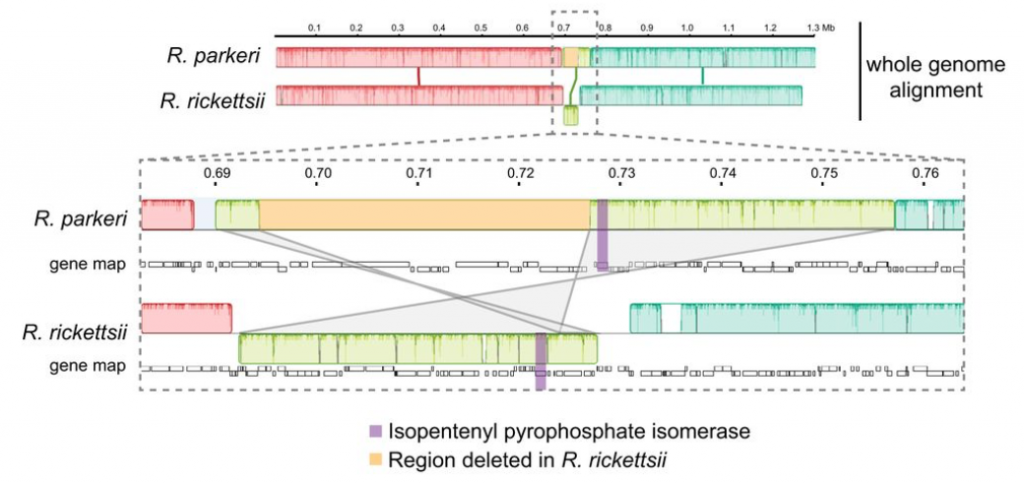Burke TP, Engström P, Tran CJ, Langohr IM, Glasner DR, Espinosa DA, Harris E, Welch MD. Interferon receptor deficient mice are susceptible to eschar-associated rickettsiosis. Elife. 2021 Aug 23;10. doi: 10.7554/eLife.67029. PMID: 34423779.
Brief summary: Why do arthropod-borne pathogens cause disease in humans, yet animal reservoirs in the wild are highly resistant to infection? Here, we show that the innate immune cytokines type I and type II interferon redundantly protect mice from the tick-borne pathogen Rickettsia parkeri, which causes skin lesions (eschars) and disseminated disease in humans. This study shows that human disease may be due to an insufficient interferon response and provides an improved mouse model to investigate vaccines and therapeutics.
Burke TP, Engström P, Chavez RA, Fonbuena JA, Vance RE, Welch MD. Inflammasome-mediated antagonism of type I interferon enhances Rickettsia pathogenesis. Nat Microbiol. 2020 May;5(5):688-696. doi: 10.1038/s41564-020-0673-5. Epub 2020 Mar 2. PubMed PMID: 32123346; PubMed Central PMCID: PMC7239376.
Brief summary: Inflammasomes and interferons are two major arms of innate immunity. Intracellular bacteria are generally restricted by the cytokine interferon-gamma whereas viruses are restricted by type I interferon. It has remained unclear how obligate cytosolic bacteria, which have a virus-like intracellular life cycle, interact with inflammasomes and interferons. Here, we show that the obligate bacterial pathogen Rickettsia parkeri exploits the inherent trade-off between inflammasome-mediated cell death and type I interferon production. We explore these mechanisms and show that the cytosolic antimicrobial GBPs can kill R. parkeri to activate the caspase-11 inflammasome, lysing the host cell to prevent type I interferon produced by the DNA sensor cGAS. These interactions between R. parkeri and innate immunity are more similar to viral interactions with innate immunity, suggesting that the innate immune system evolved mechanisms to target obligate pathogens.
Engström P, Burke TP, Tran CJ, Iavarone AT, Welch MD. Lysine methylation shields an intracellular pathogen from ubiquitylation and autophagy. Sci Adv. 2021 Jun;7(26). doi: 10.1126/sciadv.abg2517. Print 2021 Jun. PMID: 34172444; PMCID: PMC8232902.
Engström P, Burke TP, Mitchell G, Ingabire N, Mark KG, Golovkine G, Iavarone AT, Rape M, Cox JS, Welch MD. Evasion of autophagy mediated by Rickettsia surface protein OmpB is critical for virulence. Nat Microbiol. 2019 Dec;4(12):2538-2551. doi: 10.1038/s41564-019-0583-6. Epub 2019 Oct 14. PMID: 31611642; PMCID: PMC6988571.
Ahyong V, Berdan CA, Burke TP, Nomura DK, Welch MD. A Metabolic Dependency for Host Isoprenoids in the Obligate Intracellular Pathogen Rickettsia parkeri Underlies a Sensitivity to the Statin Class of Host-Targeted Therapeutics. mSphere. 2019 Nov 13;4(6). doi: 10.1128/mSphere.00536-19. PubMed PMID: 31722991; PubMed Central PMCID: PMC6854040.
McFarland AP, Burke TP, Carletti AA, Glover RC, Tabakh H, Welch MD, Woodward JJ. RECON-Dependent Inflammation in Hepatocytes Enhances Listeria monocytogenes Cell-to-Cell Spread. mBio. 2018 May 15;9(3). doi: 10.1128/mBio.00526-18. PubMed PMID: 29764944; PubMed Central PMCID: PMC5954220.
Burke TP, Portnoy DA. SpoVG Is a Conserved RNA-Binding Protein That Regulates Listeria monocytogenes Lysozyme Resistance, Virulence, and Swarming Motility. mBio. 2016 Apr 5;7(2):e00240. doi: 10.1128/mBio.00240-16. PMID: 27048798; PMCID: PMC4959528.
Burke TP, Loukitcheva A, Zemansky J, Wheeler R, Boneca IG, Portnoy DA. Listeria monocytogenes is resistant to lysozyme through the regulation, not the acquisition, of cell wall-modifying enzymes. J Bacteriol. 2014 Nov;196(21):3756-67. doi: 10.1128/JB.02053-14. Epub 2014 Aug 25. PMID: 25157076; PMCID: PMC4248804.
Durack J, Burke TP, Portnoy DA. A prl mutation in SecY suppresses secretion and virulence defects of Listeria monocytogenes secA2 mutants. J Bacteriol. 2015 Mar;197(5):932-42. doi: 10.1128/JB.02284-14. Epub 2014 Dec 22. PMID: 25535272; PMCID: PMC4325107.
Burke TP. The Unexpected Effects of the Combination of Antibiotics and Immunity. Cell. 2018 Feb 22;172(5):891-893. doi: 10.1016/j.cell.2018.02.003. PubMed PMID: 29474916.
Witte CE, Whiteley AT, Burke TP, Sauer JD, Portnoy DA, Woodward JJ. Cyclic di-AMP is critical for Listeria monocytogenes growth, cell wall homeostasis, and establishment of infection. mBio. 2013 May 28;4(3):e00282-13. doi: 10.1128/mBio.00282-13. PubMed PMID: 23716572; PubMed Central PMCID: PMC3663569.
DeYoung BJ, Qi D, Kim SH, Burke TP, Innes RW. Activation of a plant nucleotide binding-leucine rich repeat disease resistance protein by a modified self protein. Cell Microbiol. 2012 Jul;14(7):1071-84. doi: 10.1111/j.1462-5822.2012.01779.x. Epub 2012 Mar 27. PMID: 22372664; PMCID: PMC3371279.
Sauer JD, Pereyre S, Archer KA, Burke TP, Hanson B, Lauer P, Portnoy DA. Listeria monocytogenes engineered to activate the Nlrc4 inflammasome are severely attenuated and are poor inducers of protective immunity. Proc Natl Acad Sci USA. 2011 Jul 26;108(30):12419-24. doi: 10.1073/pnas.1019041108. Epub 2011 Jul 11. PMID: 21746921; PMCID: PMC3145703.
View all my publications on NCBI: http://www.ncbi.nlm.nih.gov/sites/myncbi/1NeZ7ME7eTAAe/bibliograpahy/40290992/public/?sort=date&direction=ascending
ORCiD: https://orcid.org/ 0000-0002-1385-8757












